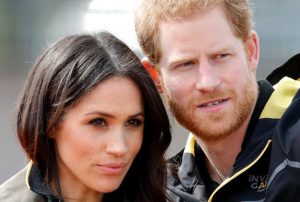JUNE 21, 2021

Meghan Markle and Prince Harry attend the UK Team Trials for the Invictus Games Sydney 2018 at the University of Bath on April 6, 2018 in Bath, England. The couple made a series of dramatic allegations against the royal family and institution during a tell-all interview in March 2021. – Max Mumby/Indigo/Getty Images
Prince Harry and Meghan Markle’s Oprah Winfrey interview triggered a 40-hour royal crisis—but forced diversity onto the palace agenda, a new biography states.
The Duke and Duchess of Sussex told the world a family member had expressed concern about how dark their unborn son’s skin might be.
And Meghan told Oprah she was left suicidal by negative press coverage, only to be told going to an institution to recover would make the monarchy look bad.
Biography Battle of Brothers, serialized in U.K. newspaper The Times, described how the palace went into crisis mode in the aftermath—but Queen Elizabeth II made the media wait an extra day to ensure she got her response right.
Author Robert Lacey wrote: “Harry and Meghan had gone out to the world on a Sunday night. On Monday morning, Buckingham Palace went into crisis mode. The three royal households representing the Queen, Prince Charles and Prince William were locked in discussions that lasted all day.
“By the end of Monday the combined efforts of the three households had hashed out a statement—a very short statement—and the press was panting at the gates. The media wanted and expected some reaction in time for the evening TV news.
“But Elizabeth II—in touch with all the family and palace discussions that day via telephone and video conference from Windsor—decided they could wait. The Queen wanted ‘to sleep on it.’ And the interview had not yet been seen by most people in Britain, since it was not scheduled to go out on ITV until 9 p.m. that night.”
The historian described how the “meat” of the monarch’s 61-word response lay in the middle of the statement that eventually followed at 5.26 p.m. U.K. time, just before the six o’clock TV news bulletins, on the Tuesday.
Released by Buckingham Palace, on behalf of the Queen, the key section read: “The issues raised, particularly that of race, are concerning. While some recollections may vary, they are taken very seriously and will be addressed by the family privately.”
Just days before the Oprah interview, U.K. newspaper The Times published extracts of an email accusing Meghan of bullying her staff at Kensington Palace.
And Lacey described how a week after broadcast “palace guidance” revealed a third-party law firm had been called in to review the allegations.
The historian then wrote: “A week later another leak revealed the planned appointment of a ‘palace diversity tsar’ to handle the racial matters.
“‘We haven’t seen the progress we would like,’ admitted a senior royal source, ‘and [we] accept more needs to be done. We can always improve.’
“Diversity! Diversity! Meghan and Harry had delivered some low blows in talking to Oprah in a thoroughly non-familial fashion, but it was impossible to swat away their essential truth.
“When Meghan had arrived in Buckingham Palace some three years earlier and had walked down any corridor—or the corridor of any other palace—to enter any office, the face of virtually every senior official whom she encountered had been white.”
However, less than three months after the announcement in March, documents unearthed by The Guardian revealed Buckingham Palace had a policy of not hiring “colored immigrants or foreigners” to clerical jobs until at least the late 1960s.
The newspaper found in Britain’s National Archives a declassified internal government memo written by a Home Office civil servant, TG Weiler, in February 1968.
At the time, the then Labour government wanted to introduce new legislation to ban discrimination in the workplace—but the palace negotiated an exemption.
Weiler summarised a meeting he had with Lord Tryon, the keeper of the privy purse, in which the senior royal family financial adviser outlined three types of job at the palace.
According to the memo published in The Guardian, these included: “(a) Senior posts, which were not filled by advertising or by any overt system of appointment and which would presumably be accepted as outside the scope of the bill; (b) clerical and other office posts, to which it was not, in fact, the practice to appoint colored immigrants or foreigners; and (c) ordinary domestic posts for which colored applicants were freely considered, but which would in any event be covered by the proposed general exemption for domestic employment.”
A Buckingham Palace spokesperson at the time told Newsweek via email: “Claims based on a second-hand account of conversations from over 50 years ago should not be used to draw or infer conclusions about modern-day events or operations.
“The principles of Crown Application and Crown Consent are long-established and widely known.
“The Royal Household and the Sovereign comply with the provisions of the Equality Act, in principle and in practice.
“This is reflected in the diversity, inclusion and dignity at work policies, procedures and practices within the Royal Household.
“Any complaints that might be raised under the Act follow a formal process that provides a means of hearing and remedying any complaint.”

Queen Elizabeth II at Royal Ascot at Ascot Racecourse on June 19, 2021 in Ascot, England. Queen Elizabeth II opted to sleep on the decision about how to respond to Prince Harry and Meghan Markle’s Oprah Winfrey, biography ‘Battle of Brothers’ states. Max Mumby/Indigo/Getty Images
Courtesy/Source: Newsweek









































































































